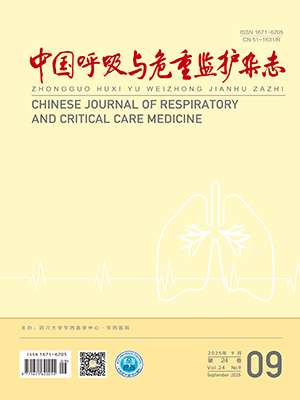| 1. |
马淑娟, 程玮涛, 徐跃峤. 神经外科重症患者计划拔管失败的相关因素分析. 神经损伤与功能重建, 2018, 13(4): 184-186, 189.
|
| 2. |
韩昌霖, 嵇朝晖, 倪水妹, 等. 颅脑外伤术后病人气管拔管失败的研究进展. 全科护理, 2020, 18(18): 2210-2213.
|
| 3. |
Namen AM, Ely EW, Tatter SB, et al. Predictors of successful extubation in neurosurgical patients. Am J Respir Crit Care Med, 2001, 163(3 Pt 1): 658-664.
|
| 4. |
Reis HF, Almeida ML, Silva MF, et al. Extubation failure influences clinical and functional outcomes in patients with traumatic brain injury. J Bras Pneumol, 2013, 39(3): 330-338.
|
| 5. |
Dawes AJ, Sacks GD, Cryer HG, et al. Compliance with Evidence-Based Guidelines and Interhospital Variation in Mortality for Patients with Severe Traumatic Brain Injury. JAMA Surg, 2015, 150(10): 965-972.
|
| 6. |
Hui X, Haider AH, Hashmi ZG, et al. Increased risk of pneumonia among ventilated patients with traumatic brain injury: every day counts!. J Surg Res, 2013, 184(1): 438-443.
|
| 7. |
Robba C, Poole D, McNett M, et al. Mechanical ventilation in patients with acute brain injury: recommendations of the European Society of Intensive Care Medicine consensus. Intensive Care Med, 2020, 46(12): 2397-2410.
|
| 8. |
Carney N, Totten AM, O'Reilly C, et al. Guidelines for the Management of Severe Traumatic Brain Injury, Fourth Edition. Neurosurgery, 2017 , 80(1): 6-15.
|
| 9. |
陈彬. 医学多因素分析设计样本例数估算—多因素分析设计样本例数综合估算法. 伤害医学(电子版), 2012, 1(4): 58-60.
|
| 10. |
Asehnoune K, Seguin P, Lasocki S, et al. Extubation success prediction in a multicentric cohort of patients with severe brain injury. Anesthesiology, 2017, 127(2): 338-346.
|
| 11. |
MacIntyre NR, Cook DJ, Ely EW Jr, et al. Evidence-based Guidelines for Weaning and Discontinuing Ventilatory Support: A Collective Task Force Facilitated by the American College of Chest Physicians; the American Association for Respiratory Care; and the American College of Critical Care Medicine. Chest, 2001, 120(6 Suppl): 375S-395S.
|
| 12. |
Schmidt GA, Girard TD, Kress JP, et al. Official Executive Summary of an American Thoracic Society/American College of Chest Physicians Clinical Practice Guideline: Liberation from Mechanical Ventilation in Critically Ill Adults. Am J Respir Crit Care Med, 2017, 195(1): 115-119.
|
| 13. |
Vetrugno L, Guadagnin GM, Brussa A, et al. Mechanical ventilation weaning issues can be counted on the fingers of just one hand: part 1. Ultrasound J, 2020, 12(1): 9.
|
| 14. |
Green SM, Haukoos JS, Schriger DL. How to measure the Glasgow Coma Scale. Ann Emerg Med, 2017, 70(2): 158-160.
|
| 15. |
Duan J, Liu JH, Xiao ML, et al. Voluntary is better than involuntary cough peak flow for predicting re-intubation after scheduled extubation in cooperative subjects. Respir Care, 2014 , 59(11): 1643-1651.
|
| 16. |
Kriner EJ, Shafazand S, Colice GL. The endotracheal tube cuff-leak test as a predictor for postextubation stridor. Respir Care, 2005, 50(12): 1632-1638.
|
| 17. |
Kuriyama A, Jackson JL, Kamei J. Performance of the cuff leak test in adults in predicting post-extubation airway complications: a systematic review and meta-analysis. Crit Care, 2020, 24(1): 640.
|
| 18. |
Girard TD, Alhazzani W, Kress JP, et al. An Official American Thoracic Society/American College of Chest Physicians Clinical Practice Guideline: Liberation from Mechanical Ventilation in Critically Ill Adults. Rehabilitation Protocols, Ventilator Liberation Protocols, and Cuff Leak Tests. Am J Respir Crit Care Med, 2017, 195(1): 120-133.
|
| 19. |
Cinotti R, Pelosi P, Schultz MJ, et al. Extubation strategies in neuro-intensive care unit patients and associations with outcomes: the ENIO multicentre international observational study. Ann Transl Med, 2020 , 8(7): 503.
|
| 20. |
Béduneau G, Pham T, Schortgen F, et al. Epidemiology of weaning outcome according to a new definition. The WIND Study. Am J Respir Crit Care Med, 2017, 195(6): 772-783.
|
| 21. |
Abedini M, Froutan R, Bagheri Moghaddam A, et al. Comparison of "cough peak expiratory flow measurement" and "cough strength measurement using the white card test" in extubation success: a randomized controlled trial. J Res Med Sci, 2020, 25(1): 52.
|
| 22. |
Smailes ST, McVicar AJ, Martin R. Cough strength, secretions and extubation outcome in burn patients who have passed a spontaneous breathing trial. Burns, 2013 , 39(2): 236-342.
|
| 23. |
Salam A, Tilluckdharry L, Amoateng-Adjepong Y, et al. Neurologic status, cough, secretions and extubation outcomes. Intensive Care Med, 2004, 30(7): 1334-1339.
|
| 24. |
Smina M, Salam A, Khamiees M, et al. Cough peak flows and extubation outcomes. Chest, 2003, 124(1): 262-268.
|
| 25. |
Su WL, Chen YH, Chen CW, et al. Involuntary cough strength and extubation outcomes for patients in an ICU. Chest, 2010, 137(4): 777-782.
|
| 26. |
Kutchak FM, Debesaitys AM, Rieder Mde M, et al. Reflex cough PEF as a predictor of successful extubation in neurological patients. J Bras Pneumol, 2015, 41(4): 358-364.
|
| 27. |
McCredie VA, Ferguson ND, Pinto RL, et al. Airway management strategies for brain-injured patients meeting standard criteria to consider extubation. A prospective cohort study. Ann Am Thorac Soc, 2017, 14(1): 85-93.
|
| 28. |
Dos Reis HFC, Gomes-Neto M, Almeida MLO, et al. Development of a risk score to predict extubation failure in patients with traumatic brain injury. J Crit Care, 2017, 42: 218-222.
|
| 29. |
Robba C, Rebora P, Banzato E, et al. Incidence, risk factors, and effects on outcome of ventilator-associated pneumonia in patients with traumatic brain injury: analysis of a large, multicenter, prospective, observational longitudinal study. Chest, 2020 , 158(6): 2292-2303.
|
| 30. |
Bai LF, Duan J. Use of cough peak flow measured by a ventilator to predict re-intubation when a spirometer is unavailable. Respir Care, 2017, 62(5): 566-571.
|




